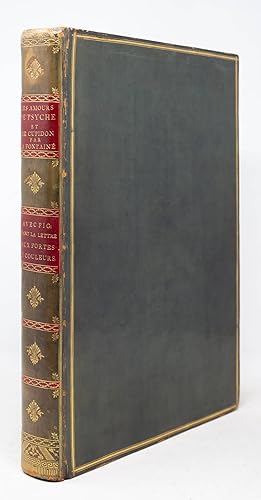Beschreibung
EXTRA-ILLUSTRATED WITH TWO PROOF-STATES FOR EACH PLATE. Paris: Didot le jeune for Saugrain, 1795 [l'an troisieme]. First Moreau edition. Folio (13 3/8" x 9 7/8", 340mm x 251mm). [Full description available.] With 26 engraved plates: an etched-engraved frontispiece (after Rigaud) in 2 states: hand-colored (mounted) and uncolored; and 8 plates in 3 states: etched-engraved without quotations from the text, engraved without quotations or makers' signatures (mounted) and hand-colored (mounted, with a tissue-guard laid in). Bound in contemporary green calf with gilt borders. On the spine, four red sheep inlays making seven primary panels. Author and title gilt to the second panel. Explanation of the extra-illustration gilt to the fourth panel. On the edges of the board, a dashed roll gilt. Gilt inside dentelles. Celadon silk crushed-velvet end-papers. All edges of the text-block gilt. Green silk marking ribbon. Moderate rubbing generally, with small patches of wear. Occasional foxing. Excellent margins (>110mm at the lower edge) and fine thick wove paper (papier vélin). Armorial bookplate of the Baron de Bellet (with his inventory manuscript: "N.o 1827") to the recto of the second free end-paper, over the oval booklabel of Baron E. Roissard (de Bellet). Armorial bookplate of "Mons. Raye, De Breukeler waert:" to the verso of the second free end-paper. An exquisite copy, made for a passionate bibliophile and collector. Jean de La Fontaine (1621-1695) is best known for his translation of Aesop's fables, the VIc BC (and later) collection of moralistic animal tales; XVIIc editions of the Fables are among the finest illustrated books ever made. In the same mode as the fables of Aesop, Les amours de Psyché et de Cupidon brings an ancient tale into the modern French milieu, in prose rather than verse. Rather like Boccaccio, La Fontaine brings a gay group into the gardens of Versailles and uses the amorous tale as a commentary on modern mores. To this is added La Fontaine's long poem Adonis, written in alexandrines. The poem accompanied the original publications of the Amours, both being fundamentally pastoral and idyllic. The illustrator for the present work was Jean-Michel Moreau the younger (1741-1814). Moreau successfully survived the Revolution; he had been dessinateur et graveur du Cabinet du Roi and yet found favor in the Republic (and managed to be re-appointed once again to the service of the king by Louis XVIII). In the present copy, his printmaking process is on fine display. Chronologically, the second of each trio of plates comes first: the engraved plate only ("avant la lettre," before the addition of text). The first is the engraved plate that has then been etched (that is, coated with a resist layer that is incised with a point, and then exposed to an acid bath ("eaux fortes") in order to eat away at the metal according to the amount of metal exposed under the resist) and the third, finally, colored by hand. The earliest recorded owner of the volume is Joan Raye, heer van Breukelerwaert (the younger; 1737-1823). He was a diplomat and traveler, but is remembered best as a passionate naturalist: he had a cabinet of curiosities including shells (now in the collection of the Natural History Museum of the Netherlands) and some of Levaillant's own bird speciments. The present volume was lot 239 in the March 1825 sale of his library by Van Cleef and Scheurleer in The Hague. The oval book-label of Eugène, Baron Roissard de Bellet (1836-1918), is completely obscured by that of a subsequent Baron de Bellet, presumably Jean Pierre Albert François (1866-1953). The family was prominent in the Alpes-Maritimes département (surrounding Nice). The book was finally purchased at the sale of Jacques Levy (Sotheby's New York, 20 April 2012, lot 194). Levy's collection was broad, but had a special strength in fine illustrated French books such at the present item. Ray, French 56; Rochambeau 24; Bocher (Moreau) 924-931. Bestandsnummer des Verkäufers JLR0310
Verkäufer kontaktieren
Diesen Artikel melden
![]()




